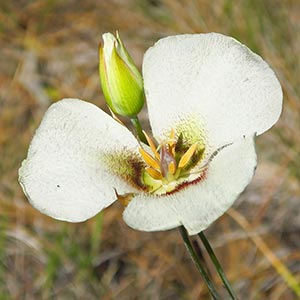Calochortus howellii
Calochortus apiculatus
Howell's mariposa lily
Baker's mariposa-lily, point mariposa-lily, point-tip mariposa lily, pointedtip mariposa lily, three-spot mariposa-lily
slender, not branching or rarely branching in axil of cauline leaf, straight, 2–4 dm.
usually not branching, straight, scapelike, stout, 1–3 dm.
basal persistent, 20–35 cm;
blade gradually tapering distally, adaxially pubescent.
basal 1–3 dm × 5–15 mm, usually shorter than stem.
subumbellate, 1–3-flowered;
bracts 2, subopposite, linear to narrowly lanceolate, attenuate, 1–3 cm.
subumbellate, 1–5-flowered;
bracts 2–several, lanceolate to linear, unequal, 1–5 cm, apex acuminate;
peduncle stout, becoming strongly deflexed in fruit.
erect;
perianth open, campanulate;
sepals shorter than petals, ovate-acuminate, glabrous;
petals yellowish white, with purplish hairs toward base, broadly obovate, cuneate, inconspicuously fringed laterally, sparingly short-hairy adaxially, apex rounded;
glands transversely oblong, slightly depressed, densely covered with short, distally branching hairs, the bases of which unite at lower margin to form inconspicuous, discontinuous membranes;
filaments shorter than anthers;
anthers oblong-lanceolate, apex acute to short-apiculate.
erect or spreading;
perianth yellowish white, sometimes streaked with purple, open, campanulate;
sepals shorter than petals;
petals oblong-lanceolate, clawed, adaxial surface densely hairy, margins fringed laterally and moderately bearded on proximal 1/2 distal to claw with slender, flexuous hairs, apex acute or obtuse;
glands short, nearly round, depressed, typically bordered proximally by dark-colored, deeply fringed membrane, adaxial surface covered with short, thick hairs;
filaments shorter than or equaling anthers;
anthers lanceolate, apex long-apiculate.
erect, 3-winged, ellipsoid, ca. 2 cm, base and apex acute.
nodding, 3-winged, ellipsoid, apex acute.
light-colored, irregular.
light brown, irregular.
= 20.
= 20.
Calochortus howellii
Calochortus apiculatus
Calochortus howellii is known only from the Illinois River valley, Josephine County.
(Discussion copyrighted by Flora of North America; reprinted with permission.)


